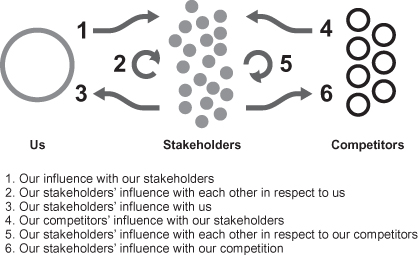Mapping the Influence Flows
We can break down interaction (reciprocal action) into action one way and action the other way. Or indeed the influence one way and the influence the other way, where the verb influence is defined as:
- Influence – to have an effect on the character, development, or behaviour of someone or something.
In other words, you have been influenced when you think in a way you wouldn’t otherwise have thought, or do something you wouldn’t otherwise have done.
This gives us six primary influence flows:
1. Our organization’s influence with stakeholders
2. Our stakeholders’ influence with each other with respect to us
3. Our stakeholders’ influence with our organization
4. Our competitors’ influence with stakeholders
5. Stakeholders’ influence with each other with respect to our competitors
6. Stakeholders’ influence with our competitors.
(I liked the term ‘influence flow’ when I first started to use it. It was only upon writing this chapter that I discovered that the word ‘influence’ itself originates from medieval Latin ‘influentia’, meaning ‘in-flow’. I hope, then, that you’ll excuse any remaining tautology.)
Figure 2.1 portrays these flows. For simplicity, I have lumped all stakeholders in the middle but, of course, our organization and our competitors may not share a universal set of stakeholders.
Figure 2.1: The Six Influence Flows

We have started ...
Get The Business of Influence: Reframing Marketing and PR for the Digital Age now with the O’Reilly learning platform.
O’Reilly members experience books, live events, courses curated by job role, and more from O’Reilly and nearly 200 top publishers.

